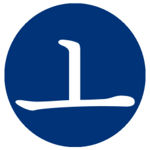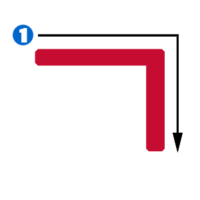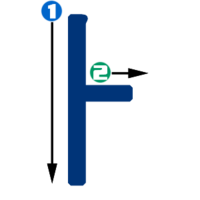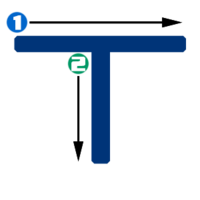Difference between revisions of "Hangeul step 2/zh-hans"
(→Real Examples) |
(→介绍Introduction) |
||
| (7 intermediate revisions by one user not shown) | |||
| Line 7: | Line 7: | ||
|} | |} | ||
| − | == | + | =='''介绍'''Introduction== |
Since consonants cannot be pronounced without the help of a vowel, we have decided to teach you the vowel first, then proceed to pair it with a consonant. Note some of these files are set to loop, so you must manually stop the files yourself. | Since consonants cannot be pronounced without the help of a vowel, we have decided to teach you the vowel first, then proceed to pair it with a consonant. Note some of these files are set to loop, so you must manually stop the files yourself. | ||
In this lesson, you will learn: | In this lesson, you will learn: | ||
| − | * | + | *声母=辅音Consonants: [[ㄱ]], [[ㄴ]], [[ㅁ]], [[ㄷ]], [[ㅇ]] |
| − | * | + | *韵母=元音Vowels: [[ㅏ]], [[ㅜ]], [[ㅗ]], [[ㅣ]] |
{{Hangeul intro table/zh-hans | {{Hangeul intro table/zh-hans | ||
|bgcolor = {{kred}} | |bgcolor = {{kred}} | ||
| − | |Consonant = ㄱ | + | |Consonant = ㄱ(辅音) |
|Cons image = ㄱ.jpg | |Cons image = ㄱ.jpg | ||
|Cons text = This is pronounced like a mix between a G and a K at the beginning of a word. However, when found between vowels, the sound is voiced and makes a /g/ sound. For full information about this letter, see [[ㄱ]]. | |Cons text = This is pronounced like a mix between a G and a K at the beginning of a word. However, when found between vowels, the sound is voiced and makes a /g/ sound. For full information about this letter, see [[ㄱ]]. | ||
| − | | | + | |Vowel = ㅏ(元音) |
|Vowel image = ㅏ.jpg | |Vowel image = ㅏ.jpg | ||
|Vowel text = For full information about this letter, see [[ㅏ]]. | |Vowel text = For full information about this letter, see [[ㅏ]]. | ||
| Line 39: | Line 39: | ||
{{Hangeul intro table/zh-hans | {{Hangeul intro table/zh-hans | ||
|bgcolor = {{kred}} | |bgcolor = {{kred}} | ||
| − | | | + | |Consonant = ㄴ(辅音) |
|Cons image = ㄴ.jpg | |Cons image = ㄴ.jpg | ||
|Cons text = This sound is the same as the N sound in English. For full information about this letter, see [[ㄴ]]. | |Cons text = This sound is the same as the N sound in English. For full information about this letter, see [[ㄴ]]. | ||
| − | | | + | |Vowel = ㅜ(元音) |
|Vowel image = ㅜ.jpg | |Vowel image = ㅜ.jpg | ||
|Vowel text = This sound makes an "ooh" sound, similar to 'm'''oo'''n' or 'bl'''ue'''' or the U sound in Spanish (i.e. '''u'''sted in "usted"). For full information about this letter, see [[ㅜ]]. | |Vowel text = This sound makes an "ooh" sound, similar to 'm'''oo'''n' or 'bl'''ue'''' or the U sound in Spanish (i.e. '''u'''sted in "usted"). For full information about this letter, see [[ㅜ]]. | ||
| Line 67: | Line 67: | ||
{{Hangeul intro table/zh-hans | {{Hangeul intro table/zh-hans | ||
|bgcolor = {{kred}} | |bgcolor = {{kred}} | ||
| − | | | + | |Consonant = ㅁ(辅音) |
|Cons image = ㅁ.jpg | |Cons image = ㅁ.jpg | ||
|Cons text = This sound is the same as the M sound in English. For full information about this letter, see [[ㅁ]]. | |Cons text = This sound is the same as the M sound in English. For full information about this letter, see [[ㅁ]]. | ||
| − | | | + | |Vowel = ㅗ(元音) |
|Vowel image = ㅗ.jpg | |Vowel image = ㅗ.jpg | ||
|Vowel text = For full information about this letter, see [[ㅗ]]. | |Vowel text = For full information about this letter, see [[ㅗ]]. | ||
| Line 102: | Line 102: | ||
{{Hangeul intro table/zh-hans | {{Hangeul intro table/zh-hans | ||
|bgcolor = {{kred}} | |bgcolor = {{kred}} | ||
| − | | | + | |Consonant = ㄷ(辅音) |
|Cons image = ㄷ.jpg | |Cons image = ㄷ.jpg | ||
|Cons text = This is pronounced like a mix between the sounds of a T and a D at the beginning of a word. However, when found between vowels, the sound is voiced and makes a /d/ sound. For full information about this letter, see [[ㄷ]]. | |Cons text = This is pronounced like a mix between the sounds of a T and a D at the beginning of a word. However, when found between vowels, the sound is voiced and makes a /d/ sound. For full information about this letter, see [[ㄷ]]. | ||
| − | | | + | |Vowel = ㅣ(元音) |
|Vowel image = ㅣ.jpg | |Vowel image = ㅣ.jpg | ||
|Vowel text = This sound is similar to the 'ee' sound in 's'''ee'''' or 'fr'''ee'''.' For full information about this letter, see [[ㅣ]]. | |Vowel text = This sound is similar to the 'ee' sound in 's'''ee'''' or 'fr'''ee'''.' For full information about this letter, see [[ㅣ]]. | ||
| Line 142: | Line 142: | ||
{{Hangeul intro table extra | {{Hangeul intro table extra | ||
| − | |char = ㅇ ( | + | |char = ㅇ (辅音consonant) |
|Image = ㅇ.jpg | |Image = ㅇ.jpg | ||
|Text = ㅇ represents no sound when found in the initial position of a syllable. Instead, it simply acts as a placeholder since <u>vowels cannot be written by themselves</u>. However, if ㅇ is in the final (bottom) position, it makes an "ng" sound, i.e. 'si'''ng'''' or 'wro'''ng'''' ([[IPA]]: ŋ ), but these final position sounds will not be discussed until [[Hangeul_step_5|step 5]] of this lesson. For now, think of it as a placeholder for a consonant when only a vowel sound must be written. For full information about this letter, see [[ㅇ]]. <!--Insert picture--> | |Text = ㅇ represents no sound when found in the initial position of a syllable. Instead, it simply acts as a placeholder since <u>vowels cannot be written by themselves</u>. However, if ㅇ is in the final (bottom) position, it makes an "ng" sound, i.e. 'si'''ng'''' or 'wro'''ng'''' ([[IPA]]: ŋ ), but these final position sounds will not be discussed until [[Hangeul_step_5|step 5]] of this lesson. For now, think of it as a placeholder for a consonant when only a vowel sound must be written. For full information about this letter, see [[ㅇ]]. <!--Insert picture--> | ||
| Line 170: | Line 170: | ||
|} | |} | ||
| − | ==Real Examples== | + | =='''具体例句'''Real Examples== |
{| class="wikitable" style="text-align:center; margin-left: auto; margin-right: auto;" | {| class="wikitable" style="text-align:center; margin-left: auto; margin-right: auto;" | ||
|- | |- | ||
| − | ! 单词 !! | + | ! 单词 !! 发音 |
|- | |- | ||
| 가구 (家具furniture) | | 가구 (家具furniture) | ||
| Line 265: | Line 265: | ||
| <flashmp3>igida H.mp3, igida M.mp3|leftbg=003478|rightbg=c60c30|lefticon=ffffff|righticon=ffffff|loop=yes</flashmp3> | | <flashmp3>igida H.mp3, igida M.mp3|leftbg=003478|rightbg=c60c30|lefticon=ffffff|righticon=ffffff|loop=yes</flashmp3> | ||
|- | |- | ||
| − | | 이모 ( | + | | 이모 (姨妈mother's sister) |
| <flashmp3>imo H.mp3, imo M.mp3|leftbg=003478|rightbg=c60c30|lefticon=ffffff|righticon=ffffff|loop=yes</flashmp3> | | <flashmp3>imo H.mp3, imo M.mp3|leftbg=003478|rightbg=c60c30|lefticon=ffffff|righticon=ffffff|loop=yes</flashmp3> | ||
|} | |} | ||
| Line 291: | Line 291: | ||
|} | |} | ||
| − | == | + | ==视频Video== |
Watch this lesson on talktomeinkorean.com's youtube channel: | Watch this lesson on talktomeinkorean.com's youtube channel: | ||
*[http://www.youtube.com/watch?v=AqFGHMxWtYk&feature=player_embedded How to read and write Hangeul (Part 1)] | *[http://www.youtube.com/watch?v=AqFGHMxWtYk&feature=player_embedded How to read and write Hangeul (Part 1)] | ||
{| border=0 style="text-align:center; margin-left: auto; margin-right: auto;" | {| border=0 style="text-align:center; margin-left: auto; margin-right: auto;" | ||
| − | |- | + | |- |
| [[File:Back.png|link=Hangeul step 1/zh-hans|150px]] | | [[File:Back.png|link=Hangeul step 1/zh-hans|150px]] | ||
| [[File:Next.png|link=Hangeul step 3/zh-hans|150px]] | | [[File:Next.png|link=Hangeul step 3/zh-hans|150px]] | ||
|} | |} | ||
Latest revision as of 04:44, 18 January 2011
|
|
| Help · Cheat Sheet · Community portal |

|

|
Contents
介绍Introduction
Since consonants cannot be pronounced without the help of a vowel, we have decided to teach you the vowel first, then proceed to pair it with a consonant. Note some of these files are set to loop, so you must manually stop the files yourself.
In this lesson, you will learn:
|
| ||||||||||
|
For full information about this letter, see ㅏ.
|
This is pronounced like a mix between a G and a K at the beginning of a word. However, when found between vowels, the sound is voiced and makes a /g/ sound. For full information about this letter, see ㄱ. | ||||||||||
| 练习Practice | |
|---|---|
| 가 | |
|
| ||||||||||
|
This sound makes an "ooh" sound, similar to 'moon' or 'blue' or the U sound in Spanish (i.e. usted in "usted"). For full information about this letter, see ㅜ.
|
This sound is the same as the N sound in English. For full information about this letter, see ㄴ. | ||||||||||
| 练习Practice | |
|---|---|
| 누 | |
| 나 | |
| 구 | |
|
| ||||||||||
|
For full information about this letter, see ㅗ.
|
This sound is the same as the M sound in English. For full information about this letter, see ㅁ. | ||||||||||
| 练习Practice | |
|---|---|
| 모 | |
| 마 | |
| 무 | |
| 고 | |
| 노 | |
|
| ||||||||||
|
This sound is similar to the 'ee' sound in 'see' or 'free.' For full information about this letter, see ㅣ.
|
This is pronounced like a mix between the sounds of a T and a D at the beginning of a word. However, when found between vowels, the sound is voiced and makes a /d/ sound. For full information about this letter, see ㄷ. | ||||||||||
| 练习Practice | |
|---|---|
| 디 | |
| 다 | |
| 두 | |
| 도 | |
| 기 | |
| 니 | |
| 미 | |
| ||||
|
ㅇ represents no sound when found in the initial position of a syllable. Instead, it simply acts as a placeholder since vowels cannot be written by themselves. However, if ㅇ is in the final (bottom) position, it makes an "ng" sound, i.e. 'sing' or 'wrong' (IPA: ŋ ), but these final position sounds will not be discussed until step 5 of this lesson. For now, think of it as a placeholder for a consonant when only a vowel sound must be written. For full information about this letter, see ㅇ. | ||||
| 练习Practice | |
|---|---|
| 아 | |
| 우 | |
| 오 | |
| 이 | |
具体例句Real Examples
| 单词 | 发音 |
|---|---|
| 가구 (家具furniture) | |
| 가나다 (韩文声母的Korean alphabet, i.e. abc) | |
| 가다 (去/走to go) | |
| 가두다 (禁闭 /收监to lock in) | |
| 고구마 (红薯/黄树sweet potato) | |
| 고기 (肉meat) | |
| 고모 (姑妈father's sister) | |
| 구두 (皮鞋dress shoes) | |
| 기도 (祈祷/祈念prayer) | |
| 나가다 (出去go out) | |
| 나누다 (分to divide) | |
| 나무 (树/树木tree) | |
| 나오다 (出来to come out) | |
| 나이 (年龄/年纪age) | |
| 누가 (谁who) | |
| 누구 (谁who) | |
| 누나 (姐姐older sister) | |
| 다가가다 (靠近approach to someone) | |
| 다니다 (来往 to go to, work, school etc) | |
| 도구 (工具instrument,tool) | |
| 마다 (每every) | |
| 마디 (节joint, knot) | |
| 모기 (蚊子 mosquito) | |
| 아기 (宝宝 /小孩儿 baby) | |
| 아마도 (可能/也许/大概maybe,perhaps) | |
| 아우 (弟弟man's younger brother-but not used anymore) | |
| 아이 (孩子child) | |
| 오다 (来to come) | |
| 오이 (黄瓜cucumber) | |
| 이기다 (赢to win) | |
| 이모 (姨妈mother's sister) |
写字Writing
Characters are written in a certain stroke order. Korean letters are written left to right, top to bottom.
视频Video
Watch this lesson on talktomeinkorean.com's youtube channel:

|

|


















